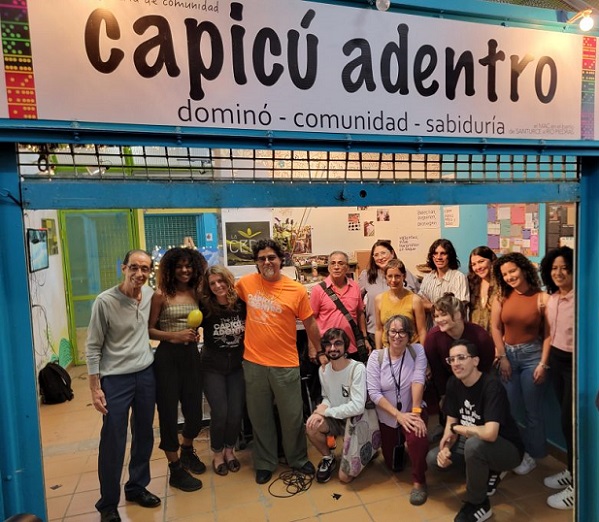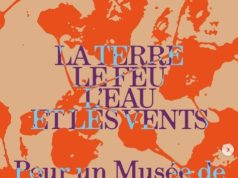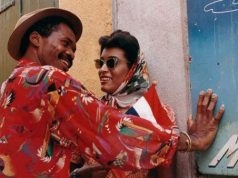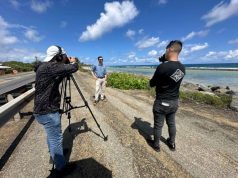
Galería Capicú Adentro [located at the Plaza del Mercado (the central marketplace) in Río Piedras] is now showing the projects created by the 10 participants in the Cultural Management course taught by Dr. María de Mater (Marimáter) O’Neill at the University of Puerto Rico-Río Piedras. The cultural management students faced the challenge of imagining possible futures using research techniques as part of this innovative course. Read more about it at Fundación Nacional para la Cultura Popular and El Nuevo Día.
Here are excerpts from “’Futuros Culturales’: una mirada académica y artística al mundo en el 2038,” by Víctor Ramos Rosado (El Nuevo Día).
Rather than just studying the past and contrasting it with the present, the students of the master’s degree in Cultural Management were led by Professor Mari Mater O’Neill on a journey to the future. But of course, being an academic space, investigative rigor is crucial. There was no room for divination here.
“This is the first class that is given on ‘prospective,’ which means studies on the future. This is not ‘Walter Mercado’ [well-known astrologer]; it is not thinking that we are talking about what is going to happen in the future; but we do work on future possibilities, so a lot of research is performed, and what you see here is the end result of that research, which is shown to the general public to get it out of the academic setting,” explained the professor during the final presentation of her group of students in an exhibition entitled “Futuros Culturales” [Cultural Futures].
The exhibition took place at the Capicú Adentro gallery and community space, located in the heart of the Plaza del Mercado in Río Piedras. The students in the course directed by O’Neill had to present their pieces in a format that evokes the cross between a science fair and an art show. But how does the process of imagining possible futures work?
“We work with different scenarios, positive and negative, the desired one, the one you would like it to be, the one you think is going to come and you want to mitigate, those are all the projects that we are seeing here. So, so that people can imagine, without being solely theoretical, we created the artifact of the future,” said the professor.
One of the students in the course, Vladimir Pérez Carucinni, decided to work with the future of sound. Having worked with music for many years, he took on the challenge of trying to open himself up to all possibilities, a method that he described as something completely new in his academic experience. “Well, the reality is that I did not know this methodology of futures perspective and study prior to the master’s degree. So, it was a very innovative course for me and very dynamic in that sense,” Pérez Carucinni explained. His work, titled “The Futures of Audio Uses and Formats,” outlines several scenarios that discuss how music, ambient sound, and even podcasts could look and sound in 15 years. [. . .]
Another student in the class was Myrta Fourquet, who chose to work with the possible futures of vinyl records, a format that has recently gained popularity and has found new life in the hands of collectors. “Vinyl is an object that is from the past, but that a few years ago is going through a strange rebirth. Digital and downloads are ahead, but vinyl, I don’t know why, young ‘digital-minded’ people have an obsession with acquiring it. And from there, I began the search to see what sparked that interest. And I realized that it was like a nostalgia for ‘retro’ objects,” explained Fourquet, who, taking this as a starting point, imagined a future in which consuming and collecting vinyl is as common as going for a coffee.
Inspired by this, she created her “artifact of the future,” one of the requirements set by Professor O’Neill. This artifact must be the product of research and the particular predictions of each student, as it forces them to put their theories into practice in the form of an imaginary, but practical object.
In the future of Fourquet, there is a type of “coffee shop” dedicated to the sale of coffee and vinyl. [. . .]
Excerpts translated by Ivette Romero. For original article (in Spanish), see https://www.elnuevodia.com/entretenimiento/cultura/notas/futuros-culturales-una-mirada-academica-y-artistica-al-mundo-en-el-2038/
Also see https://prpop.org/2023/12/futuros-culturales-2038-en-perspectiva/
[Top photo by Javier Santiago / Fundación Nacional para la Cultura Popular. Second photo by Pablo Martínez Rodríguez.]
Galería Capicú Adentro [located at the Plaza del Mercado (the central marketplace) in Río Piedras] is now showing the projects created by the 10 participants in the Cultural Management course taught by Dr. María de Mater (Marimáter) O’Neill at the University of Puerto Rico-Río Piedras. The cultural management students faced the challenge of imagining possible






